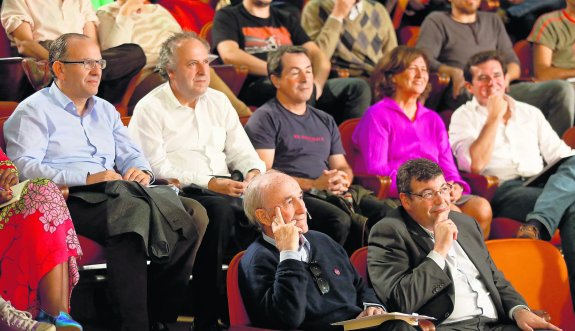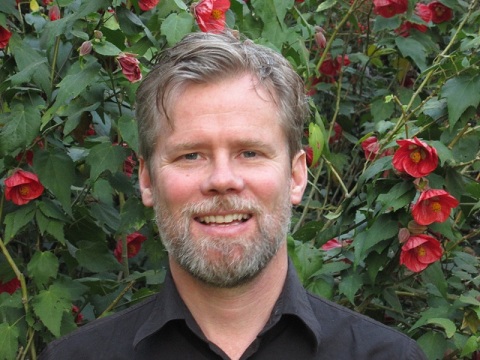My trip to Gijon, Spain for the Beyond the Sharing Economy conference began five months earlier 30 feet underground in the catacombs of Paris.
Let me explain.
Last May, I was invited to speak at OuiShare Fest in Paris. The night after a talk I gave on sharing cities, I bumped into my friend Mike Zuckerman of Freespace at BlaBlaCar’s reception. He mentioned in passing that he was going into the catacombs later that night. I responded, “don’t leave without me.”
After the reception, Mike and I headed to dinner with Chelsea Rustrum, Jason Fresco, and a couple others who would later opt-out of the catacombs adventure. We enjoyed a leisurely late dinner, Jason bought two bottles of wine to go, we said goodbye to the sensible folk, then took a cab to southwest Paris to find an entrance to the catacombs.
After being dropped off on a quiet street corner around midnight, Mike lifted the grate to a utility bunker underneath the sidewalk, lowered himself in, and disappeared. After reporting back, Jason, Chelsea, and I descended one at a time following his instructions, contorting our bodies to make it through a series of tight passages – with cables, spider webs, and dust everywhere — only to discover that the steel ladder Mike had used just two weeks earlier to descend to the catacombs had been cut short by the “catacops,” a special police unit that patrols the catacombs.
We climbed out. I thought that was it. We were milling on the corner talking about what to do next when Mike struck up a conversation with a passerby. Coincidentally, this stranger, Marcus, was headed to another entrance to the catacombs.
We followed Marcus over a tall fence nearby, then down an abandoned rail line. Half of the trip was through a pitch dark rail tunnel. After about a mile, we stopped in front of a trench on the side of the tunnel. This was an entrance to the catacombs. We prepped for a couple minutes. Marcus shared a few sage words of advice and gave each of us a candle. We descended, and began a long walk underground.
We spent the rest of night exploring the catacombs. We walked a few miles, 30 feet underground, in a series of tunnels, caves, and passages hewn from rock, some filled knee-high with water, some only passable by sliding on your belly, some filled with human bones. We saw a surprising amount of art including sculpture, mosaics, graffiti, and Dadaesque gestures. For instance, someone had gone to a lot of trouble to drag two Velib bikeshares deep into the catacombs. I chuckled at that one. Later we discovered an ornate mosaic street sign at an intersection. It was beautiful and useless. It mocked the rugged setting and the idea of getting your bearings down there. There was a situationist strain of humor in the art reminiscent of Burning Man. The irreverent, irrepressible creativity was surprisingly heart-opening.

Two Velib bikeshare bikes in the catacombs of Paris. Ready made art in the Dada tradition?
After sharing some wine in the Ram Room, one of the many outlaw social spaces in the catacombs, and exploring a bone-strewn cavern adjacent to it, we headed out. Dawn was breaking when we made it to the street again. I felt exhausted, overwhelmed, and extremely grateful. I knew others felt similarly. The five of us stood in a circle in the middle of the street. We hugged all at once shoulder-to-shoulder, then dispersed. I caught a cab back to the hostel for a couple hours of sleep before day two of OuiShare Fest.
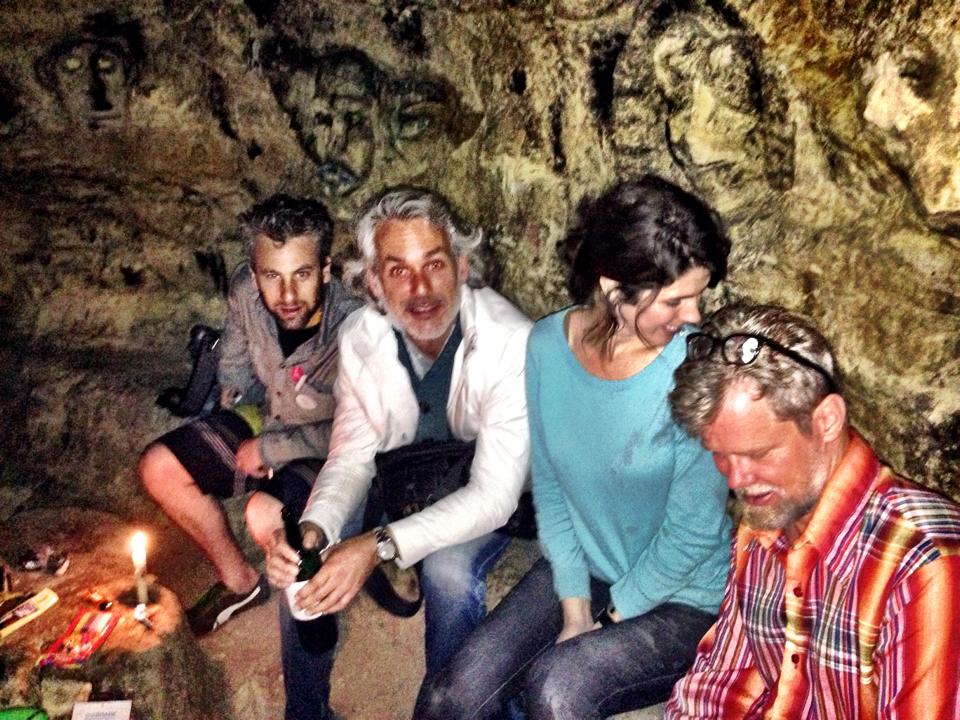
Mike Zuckerman, Jason Freskos, Chelsea Rustrum, and I share wine in the Ram Room
This experience had a profound impact on me. At first, I only knew that I had experienced something important. I didn’t know what it meant. Later, I began to understand. We had explored a 200 mile underground network of temporary autonomous zones together. The freedom and bonding found in that shared adventure was electrifying. It made me feel like anything was possible. It made me feel fully alive. And with that came a deep satisfaction, a deep gratitude.
It got me thinking about my own struggle to become a fully-realized human being and help create a sharing movement that I felt in my bones was the best hope for humans to come into our own, and save ourselves. I began to reframe this struggle through the lens of my experience in the catacombs.
The next day I met David de Ugarte at OuiShare Fest. His reputation preceded him. He is a well-know Spanish cyberpunk, activists, and author. He is a self-described coop monk as well as a cofounder of Las Indias Cooperative, of which he is an active worker-owner. He made his name in the early oughts with a trilogy about network society (highly recommended) that was a best-seller in Latin America. His intellect is only matched by his joie de vivre, optimism, and sense of humor. We hit it off.
In one exchange, I blurted out my new, though perhaps half-baked formulation, the one brewing in my mind from the night before, of what I thought the human experience (or maybe just mine) was all about — that we long to be on a great adventure with people we love to explore or create new worlds together.
Judging from David’s expression, that seemed to resonate. Later during OuiShare Fest, I suggested we do a project together. I had no idea what. I was following an intuition about David, and also what I thought was possible in the Latin world, a world where people and quality of life seem to come first more often than in the United States, where a different development path seems to be unfolding, where cities are seen as temples of well-being rather engines than of economic growth. I wanted to explore this.
Fortunately, David took my suggestion seriously. We exchanged a few e-mails after the conference. Las Indias developed an event concept called Shareable Labs with my input. They shopped the idea around in Northern Spain where they are headquartered. They hit pay dirt in Gijon, the largest city in the autonomous community of Asturias. The city was interested Shareable Labs, but a first step was a two day event, later named Beyond the Sharing Economy, which the city would support.
Before I knew it I was off to Gijon
I landed in Oviedo on Saturday October 4th in the late afternoon. Someone from Las Indias was to pick me up. I had a hunch I’d be greeted differently. They didn’t disappoint. The entire event team came to collect me – Natalia, Caro, Maria, and David. My travel fatigue was instantly erased. It was a heartwarming welcome, typical of the way Las Indias does things — people first. We crammed into their coop’s shared car and headed to Gijon.
After dropping my luggage at the hotel, we went to a cideria in the old Roman part of town for the first of many cider sessions. Cider is Asturias’ distinctive regional beverage, a charming leftover of the area’s ancient Celtic roots and a daily cultural experience. The session began as they always did. A server held a bottle above his head and poured a small amount into a special glass held below his waist to “break” the cider. While the dramatic pour was satisfying to watch, it also served a practical purpose. It oxygenates the cider making it both more flavorful and digestible. He passed a glass to me. I consumed the cider quickly while still cold as instructed. It was delicious. I passed the glass back to the server to be used again for the next person. We shared several rounds with plenty of time in between to chat and nosh. This paced our intake while ensuring that everyone got equally, yet moderately buzzed. We sailed into the night together in a co-created ship of cheer. This was my first experience of an ancient ritual, with sharing at its core, which binds Asturians to each other and the land in a simple, yet powerful way. I loved it.

An old Roman square in Gijon now home to a number of Ciderias
Indeed, it was the perfect way to begin my stay in Gijon and get to know team Las Indias better. Over cider and tapas, they filled in some details of the coming event and the story they told me before I arrived and that I would hear many times over the course of my stay, their story of the Anchovy League.
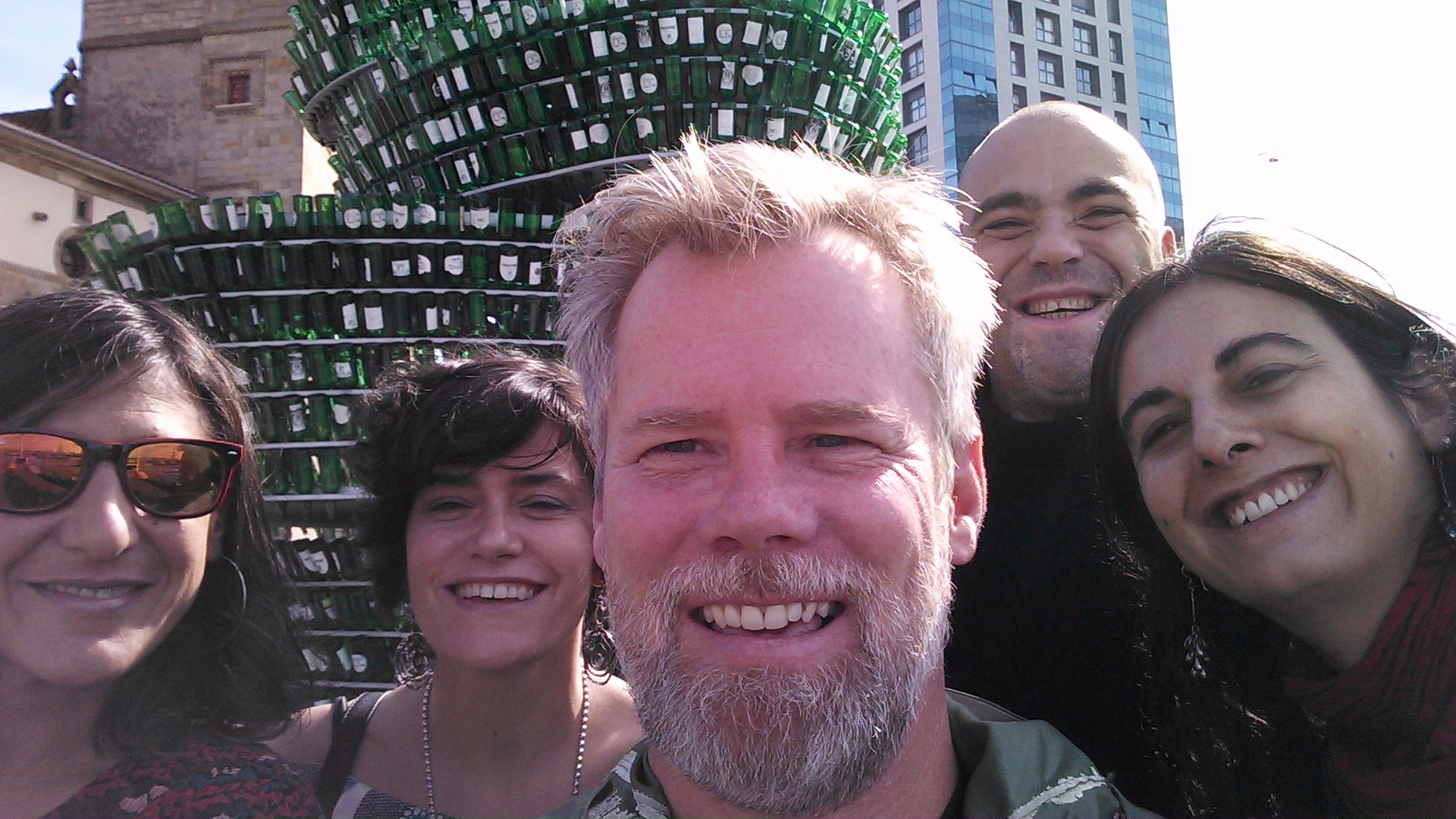
Selfie with Caro, Natalia, David and Maria of Las Indias coop in front of a sculpture made of cider bottles in Gijon's port.
The Anchovy League
The story goes something like this. An innovator in seafood canning emerged at the start of the last century among Italian immigrant merchants who had moved to the Cantabrian coast decades earlier because of a shortage of fish back home. These immigrants were loved by the locals. For one thing, they created much needed jobs. This innovator, Giovanni Vella Scatagliota, invented the anchovy product as we know it today, which catalyzed a period of industrial expansion along the Cantabrian coast including in Gijon.
Indiano Natalia Fernandez summed this up in a more interesting way, “the incredible story of a Sicilian guy who traveled to the Cantabrian looking for providers [of fish], fell in love with a girl from Santoña, invented anchovies in oil, created hundreds of jobs, and ended up changing the world’s diet.” Her longer history here is a fantastic read.
David de Ugarte's recent TEDxRio talk (in Portuguese) exploring the transformative potential of the Camino de Santiago and the Anchovy League
The lesson she draws from history is that a new, post-industrial cycle of development in the region is more likely if there’s links to innovators from elsewhere. Thus, the rationale for the Anchovy League, its inaugural event in Gijon, Beyond the Sharing Economy, and a global group of participants. The Anchovy League is an emerging innovation network in the southern part of the Atlantic Arc that hopes to catalyze a new round of development using a commons-based strategy similar to FLOK Society’s approach in Ecuador, but by linking small to medium-sized cities in a multi-country region rather than through a single nation-state. It’s also a story of rebirth, and it’s likely no accident that a fish, a very social one at that, is at the center of this history-backed, future-forward myth as fish are an ancient symbol of transformation.

The Atlantic Arc, a distinct biological, cultural, and economic region. From the Toneta Project.
The Main Event
Las Indias had designed the program for Beyond the Sharing Economy as a series of conversations among experts over two days. The discussions formed a narrative arc that lead from first principles and the personal scale to specific projects and the regional scale. It was a well-thought out design with Las Indias’ distinctive narrative approach to economic discourse. The content went well beyond the typical sharing economy talk, which usually centers on famous for-profit companies like Airbnb, into familiar territory for Shareable — the commons. I was part of two conversations, one per day.
The event was held in an auditorium at Universidad Laboral, a gigantic Franco-era campus featuring monumental Neo-Herrerian architecture. It’s the largest building in Spain according to Wikipedia. Towering above the main courtyard is a huge stone eagle with Spain’s coat of arms held in its claws, a potent symbol of Franco’s tight grip on Spain during his 36 year dictatorship. Laboral is underutilized due to the region’s industrial decline, though it’s being leveraged to revive the area. It houses a number of schools and an exhibition space for science, technology, and cultural events. And is part of a larger technology park that promises revival. Our event was a part of this mix.

The main courtyard of Laboral.
David interviewed me for one of the opening talks. He asked about the origins of Shareable, which is fitting since Shareable was founded five years before almost to the day. I talked about what inspired me and the five years I co-hosted the Abundance League, a now dormant San Francisco salon about sharing that’s a precursor to Shareable. My main point was that social isolation is a kind of living death. Sharing breaks it, unlocks our creative potential, and binds us in a cycle of mutually assured self-actualization.
At the break, the indie band G.P.S. Project played a spine-tingling acoustic version of the Police’s “So Lonely.” That was the perfect song for the moment, at least for me. I felt validated and grateful. The more I push for a life of uncompromised humanity, the more the world seems to open up to me.
That moment was topped by an incredible after-party — one part planned, one part improvised. The entire conference was bused to a llagares (cider cellar) for an Asturian espicha (feast) with plenty of cider, Asturian delicacies, and local organic wines curated by Malena Fabregat. The outstanding local fare was only surpassed by the people I met.

Beyond the Sharing Economy participants at a local llagares for a celebratory espicha. Asturians know how to live well!
After being bused back to Gijon, a group of us including commons activist Helene Finidori, Carlos Alcalde of Open City Zaragoza, Antonin Leonard and Albert Cañigueral of OuiShare, Nadia EL-Imam of EdgeRyders, Julie Da Vara and Valentine Philipponneau of Je Loue Mon Camping Car went out on the town. We stumbled into an empty bar playing 80s hits and started a dance party. Somebody bought a round of shots, and the party got a big second wind that took us well into the night.
Day two of the conference culminated in a lively, wide-ranging conversation facilitated by David between myself, Antonin, Matthew Scales of ShareNSave, and economist Juan Urrutia in which Juan really shone. That said, I disagreed with a couple his points, though I didn’t have the presence of mind to say so in the moment. When speaking about the region, he talked about a brotherhood between cities forged in competition. It was poetic, but it’s an old model. It’s worth exploring something different; that cities learn together, share on common needs, yet work separately to bring out their own unique character. Cities should not be fungible commodities. Each should be a niche unto itself. In theory, there are no losers with this strategy. In contrast, the race to the bottom to attract big corporations or become the next Silicon Valley among thousands of cities will result in mostly losers.
Then we spoke about the Camino de Santiago, the famous pilgrimage route that runs through the region and its potential for spurring social change. Prior to the panel, David and I had explored the idea of a new economy pilgrimage along the route with stops at coworking spaces, coops, and fab labs to create transformational experiences for “sharing pilgrims.” I clumsily shared the idea in its not ready for prime time state on stage. It was hard to argue with Juan when he responded that nature was a better symbol of rebirth than the camino. However, human beings need ritual to help us leave one way of life and be born into another. Pilgrimage has long served this purpose. I believe that the massive social change needed today can’t come about through technical means alone. There must be social, cultural, and, yes, spiritual dimensions. I knew from American history that the anti-slavery, women’s rights, and temperance movements emerged out of a great spiritual awakening during the 19th century. Big shifts require a level of commitment that can only be found in spirit.

The camino is many roads that lead to the same place, Santiago de Compostela, which in the old days was thought to be the end of the world. Gijon is just north of Oviedo, the capital of Asturias.
After the panel, thanks to Jacinto Santos of PENSAR Consulting, I had the opportunity to keynote Cabueñes, an annual gathering of youth policy leaders in Asturias and beyond. I opened my talk about the sharing economy describing a moment I had on the beach in Gijon two mornings before. Gijon is blessed with a large, beautiful, crescent shaped beach, the Playa de San Lorenzo, that’s their equivalent of New York City’s Central Park. The promenade bordering the beach is used at nearly all hours. Hundreds of people can be seen playing on the broad, flat sand beach during the day, even in the off season. There’s even an adult soccer league that plays on the beach at low tide.
I made of point of walking the beach every day. And on this sunny morning, the simple pleasure of this beach, and its centrality to the way of life in Gijon, hit home. As I was walked barefoot on wet sand along the surf, I heard the old church bell ring, construction work in the city center, and a bag piper playing for change on the promenade. Young and old were enjoying the beach with me — some in surf, some on sand. A few feet away a municipal worker in an orange vest was taking measurements in the water. There were a couple surfers near the point. All of this registered at once. I felt part of this place. It was beautifully alive. I felt alive. What’s an economy good for unless it frees us to enjoy nature and each other like this? I urged the group to not mistake the means for the end. The end is well-being. An economy is a tool that is only as good as its ability to foster it.

The Playa de San Lorenzo, the main beach in Gijon. The church tower marks the area of the old Roman settlement. Credit: Las Vegas Apartamentos Rurales.
In the days following Beyond the Sharing Economy, I was fortunate to be the guest of Natalia, Caro, Maria, and David of Las Indias who showed me around Las Indias style, which means I was got the most fun, hands-on crash course about the region as is possible.
The first stop was a #MapJam with Mar de Niebla, a local nonprofit serving at risk youth in Gijon’s working-class La Calzada neighborhood. Jaucinto Santos, who impressed me at every turn with his creative dedication to the community, and Las Indias set up this commons mapping exercise with Mar de Niebla to coincide with Shareable’s Global #MapJam. Before the #MapJam got underway, I got a tour of Mar de Niebla’s youth center, converted from a defunct grocery store, in the first floor of a no frills apartment block. It was rough going in La Calzada, but the staff of Mar de Niebla radiated optimism and determination. There were pooling their community’s resources — in every possible way including labor, money, and all manner of in-kind donations — to give the most disadvantaged neighborhood kids a leg up. It was an inspiring setting for a #MapJam, which had some surprising results. Gijon’s mapjammers realized that much of the local commons is supported by the government. This has its advantages. However, the commons is vulnerable to austerity measures. The mapping exercise helped participants understand their vulnerability and begin thinking about peer-to-peer alternatives.

Mapjamming with Mar de Niebla and Las Indias
The next day we spent exploring Oviedo, the capital of Asturias. The highlight for me was the Museo Arqueologico de Asturias. I’m not a big fan of museums, but this was an outstanding one made all the better by visiting it with Las Indias for whom it has special significance. It’s the first place they encountered their wolf, an ancient Hispano-Celtic symbol meant to keep people safe from death (roughly, more on it here), which they eventually adopted for their cooperative’s logo.

Natalia and Maria of Las Indias at Oviedo's Museo Arqueologico de Asturias with their wolf
An exhibit showing the migration of the first people to the Cantabrian coast also struck me. Humans first came to the area after being literally pushed west by ice as the ice age progressed. The coastal mountains and sea-warmed weather blocked the ice’s advance. The abundant fish, game, and flora provided plenty of food. Humans have lived in the area ever since. Some think the area, along with parts of Southern France, as a cradle of European civilization. It’s no wonder given the stable weather and food supply. Gijon itself has been settled almost continuously for around 2,000 years.

The beautiful Asturian coast where rich farmland meets an equally productive sea
As we strolled the museum together, David explained that geographically advantageous, secondary cities like Gijon offer a haven from the disruptions of both global warming and global capital. As the museum showed, the stable coastal climate, plentiful rain, and ample food supply can sustain human life over many millennia. In the case of capital, small to medium-sized cities like Gijon aren’t big enough to absorb the titanic sums institutional investors need to invest. The businesses and real estate in major cities along with big swaths of farmland in Africa and South America are prime targets. Speculators drive ordinary people out of these places. This resonated. The tsunami of capital flowing into San Francisco where I work has made it the most expensive place to live in the US with the fastest growing wealth gap. It has forced many of my friends out.

Indianos at La Isla, their coop's birthplace. The name indiano refers to emmigrants to South America who returned to Spain and used their newfound wealth to help the people.
On my last day, the Las Indias crew took us to La Isla, the beach where their cooperative was conceived, followed by a hike along the sea cliffs on part of the Camino de Santiago. It’s a stunningly beautiful area. The Indiano villas in the verdant hills overlook small villages dotting a rocky coast with time-worn, crescent-shaped beaches in between. Nearly every home features a horreo, a grain crib of ancient design, which adds a distinctive touch to the landscape’s rustic beauty.
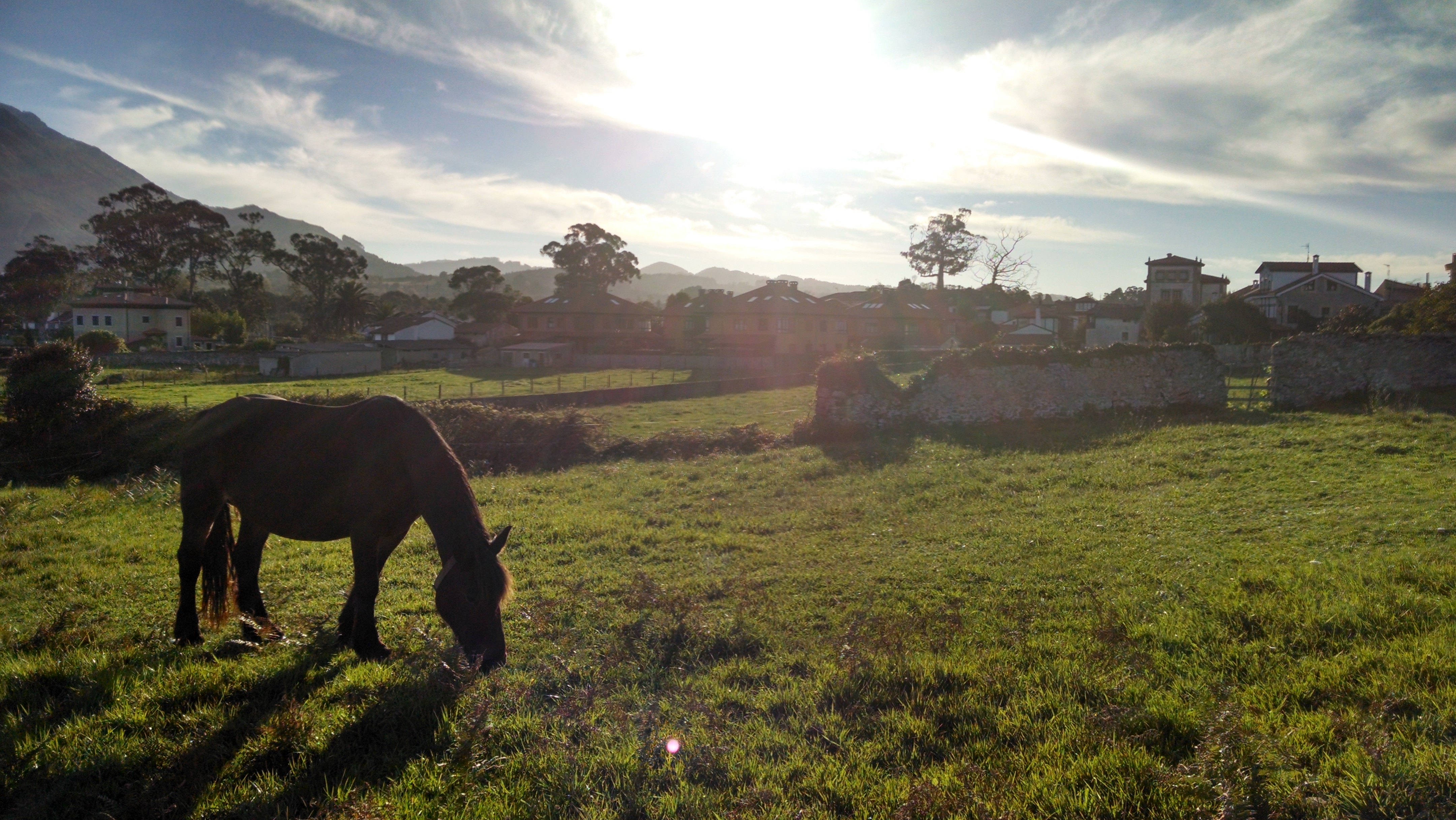
A horse grazes next to the sea in La Isla
While this post is on the long side, it hardly does my experience in Gijon justice. All the epic walks and meals with Las Indias, filled with great conversation and connection, and all the history and culture I took in but am yet to fully integrate, would be impossible to share completely. It was indeed a crash course.
Despite this, I came home with valuable lessons about myself and the sharing movement. Indeed, my trip to Gijon took me well beyond the sharing economy. For one, I have little appetite for movement as they’re generally understood. If this movement isn’t an adventure with people I love to create or explore a new world, I doubt I can contribute my best or continue for long. I felt this spirit with Las Indias, and it undoubtedly enables them to take on bold projects for social change year after year. Similarly, I doubt the sharing movement can fulfill its transformative potential if it can’t somehow draw out the full-hearted commitment of ordinary people in a way that love and an epic adventure can.
I also came to see the world’s cities as a fleet of arks that has carried our delicate species safely through the storms of time. I came to see that our generation’s great adventure is to sail this fleet through our century, which is shaping up to be the greatest storm of all time, one of our own making, one that will kill or transform us.
Like all good lessons, I’m left with better questions. Will we rise to the occasion? Who else is thrilled to their marrow for this challenge? Who else can’t believe their good luck to be given such a gift? Can we create a sharing movement that uplifts those who join, models the change sought, and attracts a legion of indefatigable contributors? And how should we prepare our urban arks to ensure that our children make it safely through this century?
These are questions we’ll explore next summer at Shareable Labs in Gijon. More on this soon.
